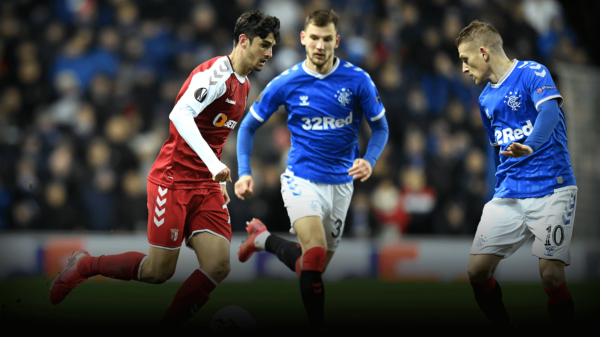Tiago Estevao provides an in-depth scout report on Paços de Ferreira’s exciting youngster, Diogo Jota.
Who is Diogo Jota?
Diogo Jota is a name that’s starting to get some reputation behind it within Portuguese football. Having a somewhat Ruben Neves-esque season in 2014/15, Diogo made his debut at only 17 years old, in a cup match against a lower division side. His performance? A goal, an assist and participation in all of his side’s 4 goals. I’d say that’s solid for a teenager, even against a third division team.

Paulo Fonseca trusted the youngster enough after that match to give him more and more chances with the first team throughout the season. At 18, he’s now a crucial part of Paços’ main eleven. That’s right, Paços de Ferreira – a side whose international reputation is extremely low when compared to the massive teams in the country. This is the exact reason why his name is starting to be known in the country while still unrecognized internationally. With that said, Jota is proof that there’s quality and potential in the more obscure teams of the nation and that for a player to be seen as a great young prospect, he doesn’t need to have been a part of any of the renowned academies in the country. Born in Massarelos, a region of Porto, the 18-year-old played for Gondomar throughout his youth years until moving to Paços at 16. His career has taken off since then.
Talent Radar Accolades:
Style of Play, Strengths and Weaknesses

Source: GSN Index SRC (Soccer related characteristics): Evaluation & characteristics (30+) which are essential for players +/- statistic: Based on performance data, players receive + and – scores for their actions on the field Potential: Modified economic and financial algorithms which show how a player will develop in the future Level of Play: The system rates and analyses every match a player has played in his entire career
Known for scoring goals from an early age, Jota was never a true striker. In fact, the Portuguese youngster has always been played more as an offensive midfielder. With Paços, Diogo was pushed higher up the pitch and since he’s been with the first team, that’s where he’s been playing. Both under Fonseca who gave the youngster his first team debut, and now under Jorge Simão.
Agile on and off the ball, with quality dribbling, the youngster is the archetype of the ideal second striker. Despite also being able to play in the highest vertex of the midfield triangle (as more of a classic number 10), or even from one of the wings, Diogo is indeed better suited for a more central role – even more so when played next to a striker whose best characteristics are more focused on the physical and positional aspects of the game. This way the duo tends to balance itself out, just like what happened last year when Diogo often played alongside Bruno Moreira. The latter ended up with 14 goals in the season, being the “classic striker”, while our 1996-born striker had more of a free role, often appearing on either wing or closer to the midfield – this way creating spaces and starting plays.
Either way, whenever it is his turn to show up in front of goal he’s been showing his capacity to finish chances, having a total of 8 goals scored for the first team, in the 23 matches played (between last season and the current one).
To give the international readers a comparison in terms of his style of play with a better known player, Diogo Jota shares a lot of traits with Paulo Dybala. Mostly in the way that both forwards can create space and play for their teammates while also being incredibly dangerous in front of goal. The weight and size similarities help make the comparison as well, with Jota being around 1.78 meters tall (Dybala’s 1.76) and while that doesn’t seem like such a high number for a striker, it’s really decent for someone as quick and agile as him.
The interesting thing about this particular player is that he shows up in the midst of a winger generation (it’s Portugal we’re talking about here, young talented wingers are pretty much everywhere) without many central forwards. And while one could argue that Gonçalo Paciência and André Silva are strikers of immense talent (especially the latter), neither of these have Diogo’s characteristics. In a time where we can see both the U21s and the main national team often trying more of a 4-4-2 diamond formation with two “free” strikers, you can’t help but wonder what are the actual possibilities for these blossoming talents to win their space in the future main Portuguese squad.
It’s very early to predict anything but who knows if we aren’t going to end up watching these talents in red shirts lifting a certain major trophy on a hot, winter night in Qatar.
What does the future hold?
Although he has signed a new contract with Paços that connects him to the club for the next five years (until 2020), Jota feels like one of those youngsters who will outgrow his club fairly soon.
On the other hand, not only do I feel like it’s not the right time for him to move away from the country but I also don’t see international clubs giving him that much thought and consideration until he proves himself at a top club in Portugal.
Another aspect that might help you elevate your expectations of Jota is the fact that his career is already managed by Jorge Mendes, the football agent with the most influence within European and perhaps even world football.
No matter where he ends up, the forward is talented enough to start establishing himself as an essential piece of the U21s and move on to bigger and better things.
Written by Tiago Estevao
- How will Pep Guardiola affect the Three Lions? - May 13, 2016
- Talent Radar: 10 Young Players to watch in MLS - March 31, 2016
- Scout Report: Miguel Silva | The youngster who bears the king on his chest - February 11, 2016

























































